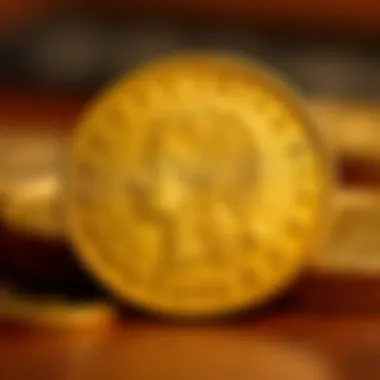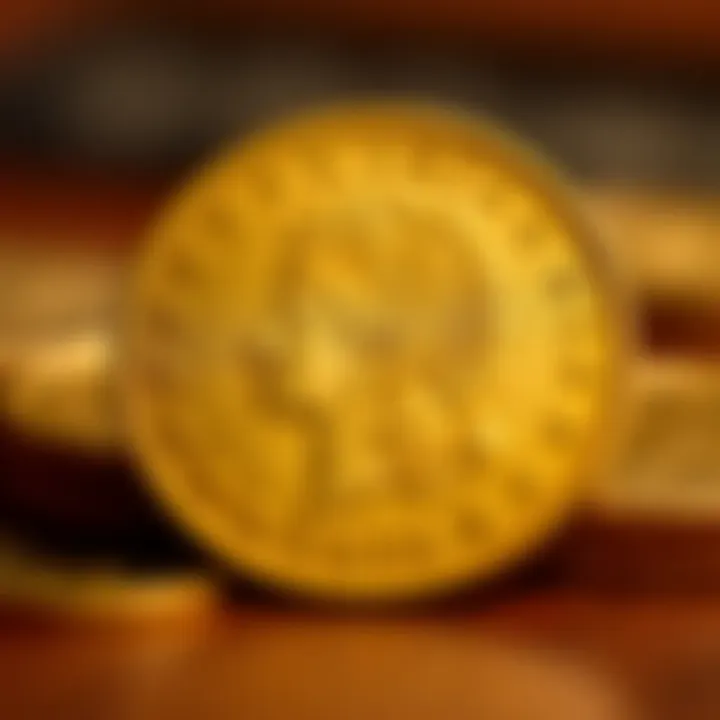In-Depth Overview of the 1873 Gold Coin's Legacy


Intro
The 1873 gold coin stands as a fascinating subject of study for numismatics, merging history, economics, and artistry in one precious artifact. From its inception during a pivotal year in American financial history, it mirrors the broader economic trends of the time—trends that shaped not only its design but also its subsequent market value. This coin is not simply metal shaped into a round form; it represents wealth, opportunity, and collectibility.
In this analysis, we will explore the genesis of the 1873 gold coin, examining its minting details, designs, and how it fits into the landscape of modern coin collecting and investment strategies. For both novice and seasoned investors alike, understanding the coin's historical relevance and its appeal in today's market is essential. Let's dive deeper.
Key Terms and Definitions
Understanding some basic terminology can really illuminate our discussion. For the non-expert, let's break down a couple of concepts that will come up throughout this analysis.
Investment Concepts
- Numismatics: The study or collection of currency, including coins, tokens, paper money, and related objects. It looks beyond mere monetary value, encapsulating history and artistry.
- Market Value: This term refers to the price at which an asset would trade in a competitive auction setting. Aspects like rarity, demand, and condition impact this value.
Financial Instruments
- Gold Coins: These coins, often considered a hedge against inflation, have intrinsic value based on their metal content. Unlike currency, their value does not diminish over time.
- Collectibles: Items valued for their rarity and historical significance, which can appreciate over time. Collectibles include not only coins but also stamps, vintage toys, and artworks.
Expert Advice
When delving into investments related to coins like the 1873 gold coin, some strategies can guide your path.
Long-term vs. Short-term Investing
Investing in gold coins is often viewed as a long-term strategy. While short-term flipping can yield profits, the right coins appreciate a great deal over time, reflecting their rarity and demand. The 1873 gold coin serves as an example where holding onto such an asset may indeed pay off considerably in the long haul.
Risk Management Strategies
As in any investment, managing risks remains critical. Here are a few pointers:
- Diversification: It’s always wise not to put all your eggs in one basket. A varied collection can safeguard against losses if the market for a specific coin falters.
- Research: Knowledge is your best friend. Being aware of market trends, historical prices, and collector interests can help inform your buying or selling decisions.
In essence, the 1873 gold coin is much more than a mere number inscribed on a piece of metal; it embodies a rich history tied to economic fluctuations. To get the pulse on its current trends, exploring secondary sources such as Wikipedia, Britannica, and collectors' forums on Reddit provides vital insights.
Stay tuned as we further dissect this fascinating topic, uncovering layers of history, value, and the nuanced world of collectors engaged in preserving artifacts from the past.
Historical Context of the Gold Coin
Understanding the historical context surrounding the 1873 gold coin provides an essential backdrop to appreciate not only its numismatic significance but also the broader economic and social dynamics of the early 1870s. At this time, the United States was in the grips of rapid change, marked by both a flourishing economy and the impending challenges that would ultimately lead to fluctuations in the money supply, which would have lasting impacts on currency production.
Economic Climate of the Early 1870s
The early 1870s were a turbulent yet transformative period for the United States. Following the Civil War, the nation was trying to find its footing, both politically and economically. The Gold Rush era had introduced a substantial influx of gold into the economy, stimulating growth but also raising concerns regarding inflation and the stability of currency values. Cities like San Francisco were booming, attracting various settlers and investors with dreams of fortune. However, this exuberance masked underlying vulnerabilities.
The economy was teetering at the edge of a financial crisis. Speculative investments were rampant, with the railroads as one of the primary sectors luring capital. All this speculation would later lead to the Panic of 1873, which would significantly affect the value and market perception of gold coins, including the 1873 piece. The burgeoning manufacturing sector and increased immigration were creating a vastly different nation, moving towards an age of industry—a significant shift from an agriculturally based economy.
In this whirlwind of uncertainty, investors and the government began reconsidering how money should be backed and circulated, leading to tensions between those advocating for a gold standard and those who supported more flexible monetary policies. The fallout from these debates brought about not only new currency designs but also public sentiment that would influence the usability and acceptance of gold coins.
The Coin Redesign and Motives Behind It
In reaction to the economic climate, the redesign of coins in 1873 wasn’t just a cosmetic change; it reflected deeper motivations rooted in both practicality and symbolism. The U.S. Mint sought to address the changing perceptions of currency amid growing public anxiety about economic stability and value retention. The redesign aimed not only to reshape the visual aspects of the gold coin but also to reinforce trust and confidence in the currency circulating at the time.
This period saw the introduction of new design elements that were intended to depict a more modern America—an emblem of national pride as the country steadily emerged from the complexities of the Civil War. The redesign signified a shift towards embracing a unified monetary system and emphasized the federal government's role in regulating currency.


Moreover, the 1873 gold coin was part of a broader transformation that included the introduction of standard weights and measurements, which helped facilitate trade and commerce. The Mint was acting in response to both domestic pressures from citizens and the wider global trends in monetary practices. By establishing a reputable gold coin in 1873, they not only intended to improve market confidence but also to ensure that the coin would hold its stature through the tumultuous economic times ahead.
The redesign shook the foundation of what people thought money should represent, and by seamlessly intertwining art with economic principle, the 1873 gold coin became an enduring snippet of the American narrative.
"A coin is not just metal. It represents trust, history, and a promise of value."
Through the lens of history, understanding the 1873 gold coin isn't merely an exercise in numismatics. It also acts as a window into an era characterized by hope and uncertainty, a reflection of the American spirit eager to embrace change while wrestling with its legacy.
Minting Details and Specifications
The minting details and specifications of the 1873 gold coin are crucial for understanding its significance within the broader landscape of numismatics. These factors not only outline how the coin came to be but also shed light on its craftsmanship, cultural importance, and economic context. Knowing how the coin was produced, where it was minted, and the materials that were used can greatly affect its value in the eyes of collectors and investors alike.
Mint Locations and Their Significance
The minting of the 1873 gold coin took place predominantly at the Philadelphia Mint, a site steeped in historical significance. Established in 1792, the Philadelphia Mint became the epitome of American coin production. In the early 1870s, this location was already recognized for its high-quality output and excellent fabrication methods, ensuring that each coin issued had integrity.
The choice of mint location also has financial implications. Coins minted in Philadelphia often held a premium due to their historical legacy. For example, coins struck at the San Francisco Mint later held a different market perception, influenced by the Gold Rush and the resulting influx of gold. The mint location can affect collector demand; coins from the Philadelphia Mint are often associated with a classic heritage, while those from newer mints may not have the same appeal.
Furthermore, the 1873 Gold Coin reflects the transitional nature of America at the time. The shift from agrarian economy to industrialization can be observed through different mint facilities that spring up across the country. Collectors often consider these shades of history when determining the desirability of a coin. In that regard, mint locations provide context not just for a collector’s portfolio but also for the understanding of American history itself.
Coin Specifications and Composition
Diving deeper into the specifications of the 1873 gold coin, one notes that it typically measured 34 mm in diameter and weighed approximately 33.44 grams, with pure gold content at about 90% and a blend of copper for durability. Understanding these details is essential because they fulfill a dual role. First, they confirm the authenticity of the coin; second, they serve to educate collectors about the nuances of valuation.
The alloy composition is notable as it was representative of the period; many coins from this era utilized gold with a high purity to maintain trust in the currency’s value. This specific blend was engineered to create a sturdy piece while reflecting the stunning quality the Mint strived for.
Not just numbers and materials, though—the design intricacies also play a pivotal role. The coin's surface, finished to a brilliant sheen, showcased the artistry involved in its creation. Moreover, it presented elements such as intricate engravings and the attention to detail that characterized the Mint’s craftsmanship. Coins like the 1873 gold coin are often evaluated not merely on their raw content but also on their aesthetic qualities—enhanced by the minting process, which, in turn, affects their perceived value in the marketplace.
In summation, the minting details and specifications provide a foundational understanding of the 1873 gold coin. They underscore the importance of its mint location and the technical aspects involved in its creation while also serving as critical influences on its allure among collectors and investors. The detailed craftsmanship, reflective of the values of its time, captivates not just the eye but also the mind, ensuring that this piece of numismatic history endures in value and significance.
Design Elements of the Gold Coin
The design elements of the 1873 gold coin serve as a direct reflection of the values and aspirations of its time. Each detail carved into its surface is not just art; it's a narrative waiting to unfold, capturing the spirit of an era when gold held a different status than it does today. In this section, we will dissect the obverse and reverse of the coin, understanding how these elements impact its significance in both historical and modern contexts.
Obverse Features and Symbolism
The obverse of the 1873 gold coin showcases a portrait of Liberty, iconically adorned with a diadem inscribed with the word "Liberty." This design choice wasn't merely aesthetic; it encapsulated the American ideals of freedom and independence. To the average citizen back then, this coin represented not just currency but a proud declaration of national identity.
One interesting aspect is the way Liberty is depicted. Unlike previous coins, this design includes more facial details, suggesting a more refined artistry that resonates with the technical advancements in engraving techniques of the early 1870s. The symbolic nature of Liberty on the coin also ties deeply into broader cultural themes, echoing the sentiments of a nation struggling with its identity post-Civil War.
The stars surrounding Liberty add another layer of meaning. They are not just decorative; they represent the states of the Union at the time, reinforcing the idea of unity. Each star is a tribute to the states from which the coin entities emanated, making this piece a somewhat patriotic object. The meticulous craftsmanship emphasizes a respect for both art and money, a sentiment that is sometimes lost in modern currency.
Reverse Design and Its Implications
Turning the coin over, we find that the reverse design is almost as significant as the obverse. Featuring a majestic eagle with wings spread, it symbolizes strength, resilience, and the potential for prosperity. The eagle clutches arrows and an olive branch, representing the duality of peace and readiness for defense, and can be interpreted as a statement about America's position in the world at that time.
Furthermore, the inscription featured on the reverse, which includes the denomination and the year, wasn't just a practical element for commerce. It served to legitimize the coin's value and connect its worth with national pride. In a time when counterfeit coins were a concern, the integrity of the design became a sort of assurance to the public. This written documentation goes beyond mere numbers; it captures a moment in economic history, and every time someone gazes at it, they see past and present intertwined.
Many collectors find the reverse design particularly appealing for its complexity and the story it tells about the nation’s aspirations at that period.
"The 1873 gold coin does not only occupy a space in the numismatic world; it holds the essence of American spirit and history."
Design elements are not just engravings; they represent the relationship between art and history, highlighting how currency serves as a vessel for national expression. By examining both sides of the 1873 gold coin, collectors and enthusiasts glean insights not just about its worth but about the very fabric of American identity during a pivotal historic moment.
Market Dynamics of the Gold Coin


Understanding the market dynamics surrounding the 1873 gold coin is crucial for both collectors and investors alike. This piece of currency is not just a relic of the past; it tells a story of economic conditions, market trends, and human behavior. The importance of delving into this topic lies in its potential to inform smart investment strategies that align with historical precedents and current market values.
Historical Value Trends
The historical value trends of the 1873 gold coin illustrate how external factors can affect numismatic value. For instance, during the late 19th century, the demand for gold coins was influenced by the country’s economic stability and gold market fluctuations. Speculators often bought and sold these coins, mimicking trends seen in stock markets today.
Taking a closer look, we can observe a pattern where the value of the 1873 coin reflects not just the intrinsic worth of gold but the prevailing sentiment of collectors and investors. In various periods since its minting, the coin's value rose and fell based on conditions like:
- Economic booms and busts: During times of financial crises, precious metals often see increased demand as people tend to seek safe havens.
- Collector interest: As demand from collectors rises, so too does the coin's market price. Certain variants of the 1873 coin have garnered particular attention due to limited mintage or design features, thus significantly influencing their historical value.
In the broader context of numismatic history, the ups and downs of the 1873 gold coin parallel events such as the Panic of 1893 or the Great Depression, where collectors found the asset class a refuge from the volatility of fiat currency.
Modern Market Valuation
When it comes to modern valuation, the 1873 gold coin presents a unique case study. Today, experts analyze various factors to appraise these coins accurately, focusing not just on historical precedents but also present-day market behaviors. Recent auctions and sales give insight into current valuations and how collectors and investors view this piece.
Modern prices of the 1873 gold coin can be influenced by aspects such as:
- Condition and grading: Coins in pristine condition frequently fetch higher prices at auctions. Grading experts provide a score based on wear, luster, and strikes, significantly impacting value.
- Market sentiment: As the economy fluctuates, so does the perceived value of gold coins. For instance, periods of hyperinflation or geopolitical instability can lead to spikes in gold coin valuations.
- Rarity: The number of coins in mint condition available in the market affects the price. Rare variants or those with historical significance typically yield higher returns.
"The gold coin market is a blend of art and finance; understanding its dynamics can unlock significant investment opportunities."
For further reading on market valuations, consult resources such as Numismatic Guaranty Corporation or the American Numismatic Association. Additionally, auctions held at platforms like Heritage Auctions can provide real-time insights into current trends.
Collectibility and Rarity
The collectibility and rarity of the 1873 gold coin not only add to its market value, they also deepen its significance in numismatic circles. Understanding why some coins fetch astonishing prices while others languish in obscurity requires a closer look at various elements that contribute to their desirability.
In the realm of collectibles, rarity acts as a beacon, drawing in collectors who are eager to add unique pieces to their portfolios. The 1873 gold coin, with its limited mintage and distinct minting history, embodies this principle well. For investors and collectors alike, recognizing what makes this coin not just a historical artifact, but also an asset, is crucial.
Factors Influencing Rarity
Several factors play a role in determining the rarity of the 1873 gold coin.
- Mintage Numbers: The exact quantity of coins produced can influence how rare a particular variant is. For instance, while the Philadelphia Mint churned out a significant number of gold coins during this era, the specific types issued in 1873 had varying mintages that contribute to their scarcity. Lower mintage typically correlates with higher desirability among collectors.
- Surviving Examples: Not every coin minted survives the ravages of time. The physical condition of each piece has a profound effect on its rarity. Coins that have been well-preserved or are in mint condition can command higher prices. For instance, the presence of fewer quality examples in circulation makes those in top-notch condition even more valuable.
- Historical Events: The 1873 coin was produced during a turbulent time in American history, marked by economic upheaval and changes in monetary policy. This context adds an extra layer of intrigue, as some coins might have been melted down or lost in economic crises, affecting their overall rarity.
- Type Variations: The existence of variations, such as different designs or mint marks, can also impact rarity. Collectors often seek specific editions, and certain variants of the 1873 gold coin are particularly sought after.
Understanding these factors sends collectors down the rabbit hole of numismatics with depth and clarity. Each aspect can fuel enthusiasm which, in turn, often leads to higher valuations in the market.
Collector Demand and Community Insights
The demand for the 1873 gold coin doesn't exist in a vacuum; it reflects a wider interest within the numismatic community.
- Enthusiast Groups: Local coin clubs and online forums like those found on Reddit provide platforms for collectors to share insights and experiences. The buzz surrounding certain coins can influence perceived value across the board. A coin discussed enthusiastically in a community can see a surge in demand.
- Investment Trends: As more individuals explore gold as a hedge against inflation or as part of diversified investment portfolios, interest in coins like the 1873 gold piece rises. Collectors who may have entered the market primarily for enjoyment find themselves part of larger financial conversations regarding precious metals.
- Social Media Influence: Platforms like Facebook and Instagram allow collectors to showcase their finds. Imagery of rare coins can drive interest and lead to heated bidding wars on auction sites. This digital age connection has transformed the landscape for coin collectors, fostering a community that values both rarity and the stories behind these artifacts.
"History is not just a tale of the past; it's the basis for today's investments."
Investment Considerations for the Gold Coin
Investing in the 1873 gold coin is not just a venture into numismatics; it is an exploration of history, economy, and value. When one contemplates the potential of this coin as an investment, it’s essential to not only understand the intrinsic worth of gold but also evaluate market dynamics, coin rarity, and collector sentiment.
The 1873 gold coin stands out in the marketplace due to its unique specifications and historical significance. In today’s economic conditions, which are often shaky and variable, holding tangible assets like this coin may provide a sense of stability. Moreover, knowing the potential risks and rewards associated with this investment can make a substantial difference in how one approaches buying and holding these coins.
Potential Risks and Benefits


Investing always comes with a set of risks and rewards, particularly in coins that have historical value. Here are some specific factors to consider:
- Market Fluctuations: The prices of gold and collectible coins can bounce around like a ping-pong ball on a hot summer day. Current economic trends, inflation rates, and geopolitical events can all impact prices.
- Authenticity Issues: The numismatic market is rife with counterfeits, particularly for high-value coins. Ensuring that your coin is genuine will require some diligence and perhaps even expert consultation.
- Maintenance Costs: Coins need to be kept in a suitable environment to prevent deterioration. Should costs related to storage and insurance be factored into your overall investment analysis?
On the other hand, there are notable benefits:
- Historical Value: As time marches forward, the relevance of the 1873 gold coin is likely to increase, boosting its collectible value.
- Cultural Resonance: Coins don’t just hold monetary value; they hold narratives. This connection to the past can create a kind of sentimental valuation that often translates into increased market interest.
- Hedge Against Inflation: Gold tends to preserve value even during economic downturns. Investors often flock to gold coins as a secure investment during precarious times.
"Rarity and demand often outweigh other factors when determining collectible value."
Long-Term Investment Strategies
When pondering the future of investing in the 1873 gold coin, it’s vital to have a game plan. Here are a few strategies:
- Diversification: Don’t put all your eggs in one basket. Combine different collectible coins and perhaps other tangible assets to mitigate risks.
- Research and Networking: Join collector communities, attend coin shows, or follow reliable numismatic publications. Knowledge is gold when investing.
- Buy at Right Time: Keeping an eye on market trends and being patient can yield fruitful results. Sometimes the best move is to hold onto your coins—even when tempted to sell.
- Future Trends: Look at demographic patterns. Younger investors may drive demand for older coins. Anticipating shifts in the collector base could pay off in the long run.
Historical Significance of the Gold Coin
The 1873 gold coin stands as a testimony to a pivotal era in the American economy, deeply interwoven with significant themes of value, trust, and the evolution of currency. Its relevance extends beyond mere numismatic interest; it embodies a crossroads where economic policies and societal sentiments converged. In this section, we will explore two primary facets of its historical significance: its imprint on American history and the cultural perceptions surrounding currency at that time.
Imprint on American History
The imprint of the 1873 gold coin is marked by several critical events during its circulation period. The coin, produced amidst a backdrop of economic turbulence, helped reflect an evolving monetary system that aimed to stabilize the economy post-Civil War. In an age where the gold standard was increasingly debated, the introduction of the 1873 gold coin played a decisive role in signifying the commitment to gold-backed currency. By adhering to this system, the government sought to restore confidence in a landscape now jittery from inflation and the aftermath of financial instability.
The act of minting this coin also represented the shift in American values toward capital and wealth, not just as material entities, but as symbols of hope for recovery and prosperity. During this time, many speculated about the future of gold versus silver, which fostered heated debates known in some circles as the "Currency Wars." This coin, therefore, became a physical representation of these discussions, underlying the constant tension between various forms of currency in a swiftly changing economy.
Moreover, the 1873 gold coin has a unique story tied to socio-political movements. It served as a lever for individuals and communities to navigate through economic hardships as they attached personal value to their currency, often seeing it as a medium of equitable exchange.* The coin's design and minting drew public interest, thus embedding itself into the cultural fabric of its time.
The significance of the 1873 gold coin isn't merely in gold content; it symbolizes a journey—a road through the complexities of an evolving economy and public sentiment toward fiscal responsibility.
Cultural Perceptions of Currency
Currency is often more than mere metal or paper; it contains various cultural meanings that evolve alongside societal norms. For Americans in the early 1870s, the 1873 gold coin represented a return to gold-backed values that many perceived as stable, reliable, and reputable. The prevailing belief was that gold provided more than a resource; it symbolized wealth in a way that other forms could not match.
At this time, currency also began to intersect with notions of integrity and trust. A gold coin served as a tangible measure of worth, imposed against the backdrop of a nation that cherished the concept of personal success. People started increasingly trusting these coins, believing that holding them would bolster their financial integrity. The coin's circulation also cultivated a sense of shared experience among the American populace, creating a collective memory tied to their economic journey.
Another point to consider is the role of the coin in cultural storytelling. It frequently appeared in literature and public discourse, reinforcing the idea that prosperity was analogous with adherence to a gold standard. As markets fluctuated, so did people's faith in the economy, and the gold coin became a recurring motif in discussions around value and fiscal policy. This cultural framing made it more than currency—it became a narrative device that illustrated the hopes and fears of an entire generation.
In essence, the 1873 gold coin holds a dual significance: it represents a critical time in the economy and reflects the evolving perceptions around currency in American culture. As we trace its history and significance, it becomes clear why this coin remains a focal point for both historical inquiry and contemporary investment discussions.
Ending: The Gold Coin Today
The significance of the 1873 gold coin extends beyond just its physical presence; it serves as a historical marker reflecting the values and economic conditions of its time. In this final section, we bring into focus the current market position of this notable coin, along with its legacy and future outlook. For collectors and investors alike, understanding these facets is crucial for appreciating the full depth of the 1873 gold coin's impact.
Current Market Position
As of today, the 1873 gold coin holds a distinct position in the numismatic market. Its value fluctuates based on various factors including its condition, rarity, and prevailing economic circumstances. Here are some key points regarding its current standing:
- Market Trends: Recently, there has been a rise in interest in vintage coins, driven partly by a surge in precious metal prices. The 1873 gold coin benefits from this trend, as it signifies historical importance alongside intrinsic value.
- Pricing: Coins in mint condition fetch high prices, often reaching tens of thousands in auctions. The pricing landscape is continuously evolving, guided by demand and economic indicators.
- Collector Base: The coin has become a staple for both amateur and experienced collectors. Online platforms such as Reddit have forums dedicated to discussing its worth, providing valuable insights and fostering a community of enthusiasts.
"In the world of numismatics, understanding market dynamics is essential to make informed choices about investments."
The high collector demand coupled with its historical relevance solidifies the 1873 gold coin as a valuable addition to any collection today.
Legacy and Future Outlook
The legacy of the 1873 gold coin is multifaceted, reflecting not just the monetary history but also societal aspects of the time. Looking ahead, it stands not only as a collector's item but also as a viable investment option. Here are considerations shaping its legacy and future:
- Continued Interest: Experts suggest that as more individuals explore alternative investments, interest in coins like the 1873 gold coin could rise, enhancing its legacy.
- Educational Value: This coin serves as a tangible connection to American history. As financial literacy continues to be a topic of discussion, historical coins are increasingly viewed as educational tools that explain monetary evolution.
- Investment Stability: In uncertain economic climates, tangible assets often retain value better than paper equivalents. Thus, the 1873 gold coin stands ready as a hedge against inflation and market volatility.
The future of the 1873 gold coin is bright, with its journey through time infusing it with a significance that transcends coin collecting.







